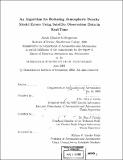An algorithm for reducing atmospheric density model errors using satellite observation data in real-time
Author(s)
Bergstrom, Sarah Elizabeth, 1979-
DownloadFull printable version (9.729Mb)
Other Contributors
Massachusetts Institute of Technology. Dept. of Aeronautics and Astronautics.
Advisor
Paul J. Cefola and Ron J. Proulx.
Terms of use
Metadata
Show full item recordAbstract
Atmospheric density mismodeling is a large source of errors in satellite orbit determination and prediction in the 200-600 kilometer range. Algorithms for correcting or "calibrating" an existing atmospheric density model to improve accuracy have been seen as a major way to reduce these errors. This thesis examines one particular algorithm, which does not require launching special "calibration satellites" or new sensor platforms. It relies solely on the large quantity of observations of existing satellites, which are already being made for space catalog maintenance. By processing these satellite observations in near real-time, a linear correction factor can be determined and forecasted into the near future. As a side benefit, improved estimates of the ballistic coefficients of some satellites are also produced. Also, statistics concerning the accuracy of the underlying density model can also be extracted from the correction. This algorithm had previously been implemented and the implementation had been partially validated using simulated data. This thesis describes the completion of the validation process using simulated data and the beginning of the real data validation process. It is also intended to serve as a manual for using and modifying the implementation of the algorithm.
Description
Thesis (S.M.)--Massachusetts Institute of Technology, Dept. of Aeronautics and Astronautics, 2002. Vita. Includes bibliographical references (p. 233-240).
Date issued
2002Department
Massachusetts Institute of Technology. Department of Aeronautics and AstronauticsPublisher
Massachusetts Institute of Technology
Keywords
Aeronautics and Astronautics.